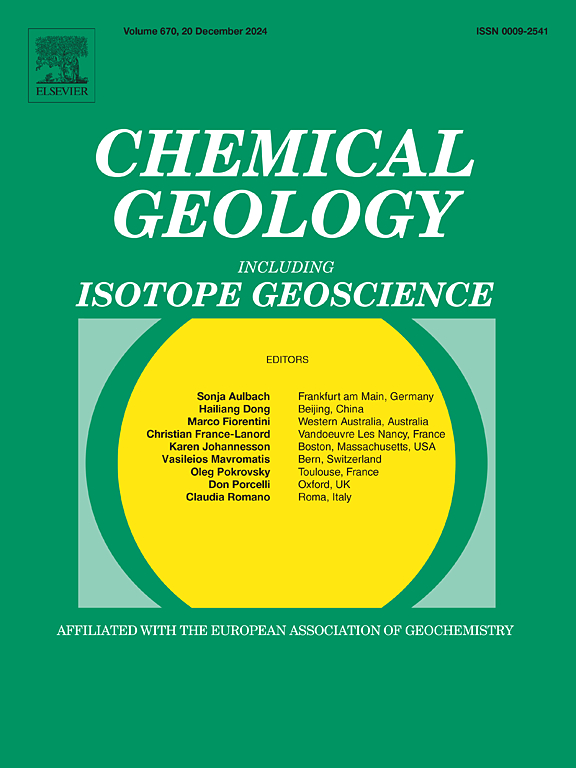Influence of clay-mineral assemblages on the B/Ga salinity proxy
IF 3.6
2区 地球科学
Q1 GEOCHEMISTRY & GEOPHYSICS
引用次数: 0
Abstract
Boron/gallium (B/Ga) ratios have proven useful in reconstructing salinity conditions in ancient shale and marl formations. Boron is adsorbed from the watermass in proportion to its aqueous concentration, yielding sedimentary concentrations many times greater than background levels, whereas Ga is present mainly in the detrital fraction. However, the amount of B uptake by a sample depends not only on aqueous B concentrations but potentially also on the mineralogical composition of the clay fraction of the sediment, which is the main host of adsorbed B. Clay minerals have varying capacities to adsorb borate (B(OH)4−), the main ionic species of boron in natural aqueous systems: highest for illite, intermediate for smectite and chlorite, and lowest for kaolinite. Thus, the salinity signal recorded by a given formation may depend on the nature of its clay-mineral assemblage. In this study, we analyzed relationships of B/Ga to clay-fraction compositions, as determined by X-ray diffraction (XRD) and geochemical (e.g., K/Al) data, for four suites of samples: (i) Modern samples from lacustrine, estuarine, coastal plain and continental shelf settings in the USA; (ii) Eocene samples from the Bohai Bay Basin of NE China; (iii) Pennsylvanian samples from the Midcontinent and Illinois basins of the USA; and (iv) Devonian samples from the Illinois Basin. Our results show that B content covaries nearly ubiquitously with total clay content, an effect explicitly compensated for by normalization of B concentration data to Ga. A key finding of our study is that, after normalization for total clay content, B/Ga ratios show no systematic relationship to any clay-mineral component in either the whole-rock or the clay-fraction data. This is good news for general application of the B/Ga paleosalinity proxy in that it suggests that the clay-mineral assemblage generally does not exert a strong influence on sediment B/Ga ratios. However, it does not preclude the existence of such influence in individual formations, and clay-fraction mineralogical analysis is a recommended auxiliary tool in paleosalinity studies. It should also be noted that all of the present study units have experienced burial heating to no higher than the oil window (∼100–180 °C), and that the influence of clay-mineral assemblages on B/Ga ratios might be manifested in other formations of greater thermal maturity. These findings will prove valuable in guiding the interpretation of elemental salinity data in future paleoenvironmental studies.
黏土矿物组合对B/Ga盐度指标的影响
硼/镓(B/Ga)比值已被证明可用于重建古页岩和泥灰岩地层的盐度条件。硼从水体中被吸附,与水的浓度成正比,产生的沉积浓度比背景浓度高许多倍,而镓主要存在于碎屑中。然而,样品对B的吸收量不仅取决于水中B的浓度,还可能取决于沉积物中粘土部分的矿物组成,这是吸附B的主要宿主。粘土矿物对硼酸盐(B(OH)4−)的吸附能力不同,硼酸盐是天然水体系中硼的主要离子种类:伊利石的吸附能力最高,蒙脱石和绿泥石的吸附能力居中,高岭石的吸附能力最低。因此,给定地层所记录的盐度信号可能取决于其粘土矿物组合的性质。本文通过x射线衍射(XRD)和地球化学(如K/Al)数据分析了四组样品的B/Ga与粘土组分组成的关系:(i)来自美国湖泊、河口、海岸平原和大陆架环境的现代样品;(ii)渤海湾盆地始新世样品;美国中部大陆和伊利诺斯盆地的宾夕法尼亚样品;(iv)伊利诺斯盆地的泥盆纪样品。我们的结果表明,B含量几乎无处不在地与总粘土含量共变,这一影响通过B浓度数据归一化到Ga来明确补偿。我们研究的一个关键发现是,在对总粘土含量进行归一化后,B/Ga比与整个岩石或粘土分数数据中的任何粘土矿物成分都没有系统的关系。这对于B/Ga古盐度指标的普遍应用是一个好消息,因为它表明黏土矿物组合通常不会对沉积物B/Ga比产生强烈的影响。然而,这并不排除在个别地层中存在这种影响,粘土组分矿物学分析是古盐度研究中推荐的辅助工具。还应该指出的是,目前所有研究单元都经历了不高于油窗(~ 100-180℃)的埋藏加热,并且粘土矿物组合对B/Ga比的影响可能表现在其他热成熟度更高的地层中。这些发现对指导今后古环境研究中元素盐度资料的解释具有重要意义。
本文章由计算机程序翻译,如有差异,请以英文原文为准。
求助全文
约1分钟内获得全文
求助全文
来源期刊

Chemical Geology
地学-地球化学与地球物理
CiteScore
7.20
自引率
10.30%
发文量
374
审稿时长
3.6 months
期刊介绍:
Chemical Geology is an international journal that publishes original research papers on isotopic and elemental geochemistry, geochronology and cosmochemistry.
The Journal focuses on chemical processes in igneous, metamorphic, and sedimentary petrology, low- and high-temperature aqueous solutions, biogeochemistry, the environment and cosmochemistry.
Papers that are field, experimentally, or computationally based are appropriate if they are of broad international interest. The Journal generally does not publish papers that are primarily of regional or local interest, or which are primarily focused on remediation and applied geochemistry.
The Journal also welcomes innovative papers dealing with significant analytical advances that are of wide interest in the community and extend significantly beyond the scope of what would be included in the methods section of a standard research paper.
 求助内容:
求助内容: 应助结果提醒方式:
应助结果提醒方式:


